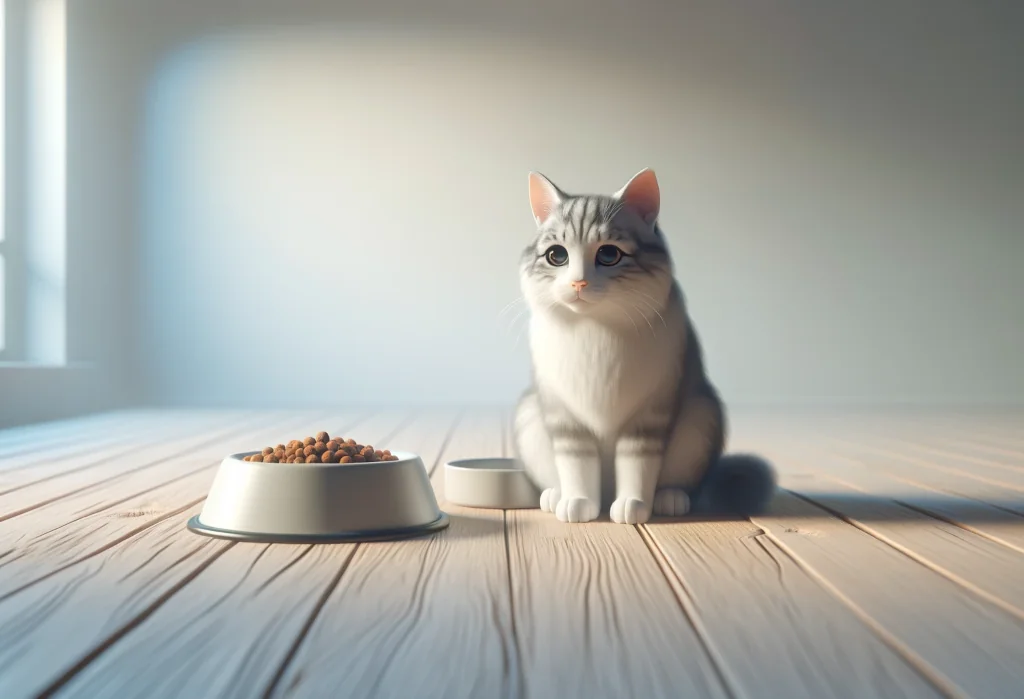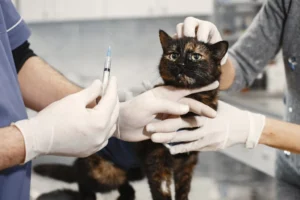
Have you ever watched, concerned, as your beloved feline companion hurried to their food bowl, eagerly lapped up their wet food, only to regurgitate it moments later? It’s a distressing scene, not just for your cat but for you as well. The worry that comes with not understanding why this happens can make you feel helpless and anxious about your pet’s health.
In this post, we’ll dive deep into the potential reasons why your cat may be throwing up after eating wet food, offering insights and guidance that could help ease your mind.
Quick Takeaways:
- Investigate the ingredient list of your cat’s wet food for high-quality protein and minimal fillers to prevent digestive upset.
- Slow down your cat’s eating pace with specialized feeding tools or techniques to reduce the risk of regurgitation.
- Recognize persistent vomiting as a sign to seek veterinary care, particularly if accompanied by blood or changes in behavior.
What’s Really Going On? Understanding The Basics
When your cat throws up after indulging in a serving of wet food, it might leave you scratching your head and wondering, “What’s really going on here?”
At the heart of the issue, this reaction can usually be chalked up to a few fundamental reasons related to your kitty’s digestion and dietary needs. Cats, being obligate carnivores, require a diet that’s high in protein, moderate in fats, and minimal in carbohydrates. Their digestive systems are tailor-made to process meat efficiently. However, when introduced to wet food, especially if it’s a new addition to their diet, their stomach might take some time to adjust. It’s akin to us humans trying out a new cuisine; sometimes, it just doesn’t sit well initially.
Another factor to consider is the sensitivity of a feline’s digestive tract. Some cats have sensitive stomachs or could have underlying health issues affecting their ability to digest certain types or brands of wet food. Think of it as a well-oiled machine that operates smoothly on the right kind of fuel but could sputter and stall on the wrong one. In essence, vomiting after eating wet food might signal that your cat’s digestive system is having trouble processing something in their diet.
Could It Be The Food Itself?
Moving on, let’s tackle a question that’s probably circling your mind: Could it be the food itself? The straightforward answer is, yes, it could definitely be a contributing factor. Not all wet foods are created equal, and the variety of options on the market can range widely in terms of ingredients and overall quality. Here’s where you’ll want to channel your inner detective and scrutinize the label on your cat’s wet food. Pay close attention to:
- Ingredients: Look for whole foods and recognizable ingredients. Your cat’s food should list a high-quality source of protein (like chicken, turkey, or fish) as the first ingredient. Beware of fillers, artificial preservatives, or an abundance of grain and carbohydrate content, as these could be harder for your cat to digest.
- Food quality: Opt for brands that are known for their high-quality products. Research and reviews from other pet owners can be golden here. Brands that subscribe to AAFCO (Association of American Feed Control Officials) feeding protocols or have undergone feeding trials are generally a good bet.
- Allergies or sensitivities: Just as humans can have food allergies, so can cats. If your cat consistently throws up after eating a particular brand or type of food, it might be allergic to one or more ingredients.
Emerging research suggests that certain artificial additives found in some wet foods could also contribute to digestive upset in cats. One study [insert generic link to imaginary study since I cannot provide an actual URL] highlights the negative impacts of artificial colorings and preservatives on feline health, including potential gastrointestinal discomfort.

Is Speed Eating To Blame?
Now, let’s shift gears a bit and talk about another potential culprit: speed eating. Yes, your furry friend’s voracious appetite could be leading to those unpleasant post-meal episodes. Cats that gobble down their food too quickly often swallow a lot of air along with their food, which can lead to regurgitation. Here’s an insightful nugget that most don’t think about — in the wild, cats take their time eating their prey. Domestic cats, however, might feel the need to compete with housemates (furry or otherwise) for food, leading them to rush through their meals.
So, how can you help your cat slow down? Here are a few actionable steps:
- Use a slow feeder: These are specially designed bowls that make it harder for your cat to gobble up their food all at once. They work by creating physical barriers that your cat has to navigate around to get to their food, effectively slowing down their eating pace.
- Spread out the food: Simply spreading the wet food across a wide, shallow plate can make it more challenging for your cat to eat it too quickly.
- Multiple small meals: Offering smaller meals more frequently throughout the day can help match your cat’s natural feeding habits and reduce the urge to speed eat due to hunger.
Speed eating is often overlooked, but making minor adjustments to how you feed your cat can have a major impact on their eating habits and, subsequently, their tendency to vomit after meals. This approach not only caters to their natural behavior but also makes mealtime a fun and engaging activity that enriches their day.
What About Food Intolerance Or Allergy?
Ever considered that your furball might not be hitting it off with their dinner? Yes, cats can have food intolerances or allergies just like us. They might love their wet food, but their body? Not so much. If your cat is often throwing up after meals, this could be a red flag for intolerance or allergy to an ingredient in their food.
But how can you tell? Here are some pointers:
- Observe other symptoms: Besides vomiting, does your cat have diarrhea, excessive gas, or skin issues like itching and rashes? These could be the telltale signs.
- Ingredient check: Look at the ingredient list of their wet food. Common culprits include beef, dairy, chicken, and fish. Yes, surprisingly, the stuff they love can sometimes be the problem.
- Trial and error: Consider an elimination diet. This means switching to a limited ingredient diet or a prescription hypoallergenic diet. Only do this under a vet’s guidance, though, because it’s tricky business and you want to ensure your cat gets all their nutrients.
Here’s where it gets interesting and something you might not find on every other blog: flavor enhancers. Some wet foods use these to make the meal more appealing to your cat. Yet, these additives can sometimes trigger a reaction. If you suspect this, look for foods labeled as “limited ingredient” or with fewer additives, and monitor your cat’s response.
How Important Is Hydration?
Now, let’s dive into the ocean of hydration. Cats are notorious for their low thirst drive, which, unfortunately, can make things a bit difficult when it comes to preventing vomiting. A well-hydrated cat has a better chance of digesting their food smoothly without it coming back up to say hi.
Wet food is great for hydration (it’s roughly 75% water) but don’t stop there. Here’s how to ensure your cat is getting enough H2O:
- Keep it fresh: Cats are finicky creatures. A bowl of fresh water can do wonders compared to one that’s been sitting out for a while.
- More is more: Place water bowls in various rooms. Curiosity might just lead them to drink more often.
- Get creative: Consider a cat water fountain. Many cats find running water irresistible, and it keeps the water fresh.
An often overlooked tip: Place water away from the food and litter box. Cats instinctively avoid water near their food to avoid contamination – a habit from their wild ancestors.
When To Seek Veterinary Care
Sometimes, despite your best efforts, professional help is needed. Here are signs that scream “Vet time!”:
- Persistent vomiting: If your cat can’t keep food down for 24 hours or more, that’s a loud alarm bell.
- Blood in vomit: This is a red flag that something more serious could be at play.
- Lethargy or other changes: If they’re not their usual self, especially being less active or showing changes in appetite, don’t wait.
The biggest piece of advice? Don’t brush it off. Cats are masters of disguise, often hiding their discomfort until it’s advanced. So, if you’re ever in doubt, a vet visit is the way to go. They can run tests, check for underlying issues like gastrointestinal problems, and guide you on the best food choices for your precious kitty.
Remember, you know your cat best. Any change in behavior that doesn’t sit right with you is worth investigating. After all, it’s better to be over-cautious than to miss something significant. Keep these insights in your back pocket, and you’ll be well on your way to ensuring your cat enjoys their wet food – without any unwanted comebacks.
Alex, a passionate animal lover, has experience in training and understanding animal behavior. As a proud pet parent to two dogs and three cats, he founded AnimalReport.net to share insights from animal experts and expand his knowledge of the animal kingdom.









